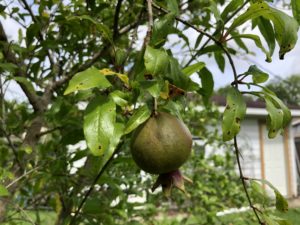 COMMON NAME: Cercospora Leaf Spot of Pomegranate
COMMON NAME: Cercospora Leaf Spot of Pomegranate
SCIENTIFIC NAME of causal agent: Cercospora punicae
DISEASE DESCRIPTION
SYMPTOMS:
Affected plants show small, dark brown spots on fruits/leaves that are initially circular but eventually become irregular as they grow. On the leaves, the lesions are dark, reddish brown to almost black and show a faint halo. The spots on fruit resemble bacterial spot, but they are darker, of various sizes, without cracks, and no stickiness. Infected twigs produce raised, black lesions, and the twigs dry out and die. More severe infections cause the leaves to turn yellow and fall prematurely. Spots on leaves decrease yield of fruit via decreased rate of photosynthesis.
BIOLOGY:
The disease begins with conidiophores arising from an infected plant surface, giving rise to conidia (spores that spread the pathogen), which break off in the wind or are splashed apart by water. Germination of conidia occurs in warm temperatures and in the presence of free moisture. Therefore, this pathogen prefers plentiful rainfall, water saturated soil, high temperatures and disease is most destructive in summer months in warm climates. The pathogen can overwinter in infected seed and as minute black stromata in old, infected leaves.
MANAGEMENT METHODS:
Losses from Cercospora spot are usually small, but in some host plants it can be significant. To decrease the risk of loss, the following tips are recommended:
- Always take care to have proper drainage to fields.
- Use disease free seed.
- Get rid of diseased fruits/leaves/twigs.
- Prune infected branches off the plant.
- Spray the plants with appropriate fungicides with active ingredients such as thiophanate, carbendazim, or propiconazole.
(Remember: pruning tools used on diseased plants should be disinfected with a 10% bleach solution, and always follow the label specifications when applying any fungicide).
RESOURCE LINKS*:
Pomegranates—Texas A&M AgriLife Extension
https://aggie-horticulture.tamu.edu/fruit-nut/files/2010/10/pomegranates.pdf
Additional Photos of Leaf Spot and Insects Targeting Pomegranates
https://plantvillage.psu.edu/topics/pomegranate/infos
Additional Fungal Disease of Pomegranate (Not Caused by Cercospora)
https://plantclinic.tamu.edu/calendar2019/pom/
This factsheet is authored by
Ashley D. Turner
pursuing a PhD. in Plant Pathology (PLPM)
Factsheet information for the plant health issues represented by the images on the 2020 TPDDL calendar were written by graduate students enrolled in the Department of Plant Pathology & Microbiology DR. DAVID APPEL’s Graduate level Introductory Plant Pathology course (PLPA601) in the 2019 Fall semester. This exercise provides an opportunity for a high impact learning activity where the students are tasked with producing an informational output directed to the general public. This activity provides an opportunity for the students to write and produce a (hopefully) useful product to communicate information on plant health issues to the public.